
TNU Journal of Science and Technology
229(06): 288 - 294
http://jst.tnu.edu.vn 288 Email: jst@tnu.edu.vn
AB-INITIO CALCULATION OF THE EXCITON LIFETIME OF INP
AND CDSE QUANTUM DOTS
Bui Thi Hanh *
Phenikaa University
ARTICLE INFO
ABSTRACT
Received:
19/4/2024
We calculate the exciton radiative lifetime of spherical Indium
Phosphide (InP) and Cadmium Selenide (CdSe) colloidal quantum
dots. In experiments, InP and CdSe quantum dots can be coated by
another semiconductor shell, organic ligands, or inorganic molecules.
In our calculation, the quantum dots are terminated by pseudo-
hydrogen to remove surface states, which are introduced by dangling
bonds. The single-particle energies and wavefunctions are obtained
using the Atomic effective pseudopotentials (AEPs) method. The
Configuration Interaction (CI) theory was used for the electronic
excitation calculations. In this work, the radiative lifetime is calculated
in the framework of the standard time-dependence perturbation theory.
The dangling bonds of anion atoms (P and Se) at the surface are
invoked to explain the finite dark exciton lifetime, which is expected to
be infinitely long in nanocrystals. Our results are in good agreement
with experimental measurements for core-shell nanoparticles but
significantly different from the quantum dots coated by organic ligands
or by more complex shells.
Revised:
31/5/2024
Published:
31/5/2024
KEYWORDS
Colloidal quantum dot
Semiconductor
Exciton
Lifetime
Optical property
TÍNH THỜI GIAN SỐNG CỦA EXCITON TRONG CHẤM LƯỢNG TỬ INP
VÀ CDSE THEO NGUYÊN LÝ ĐẦU TIÊN
Bùi Thị Hạnh
Trường Đại học Phenikaa
THÔNG TIN BÀI BÁO
TÓM TẮT
Ngày nhận bài:
19/4/2024
Chúng tôi tính toán thời gian sống của exciton trong các chấm lượng tử
InP và CdSe hình cầu. Trong thực nghiệm, các chấm lượng tử InP và
CdSe có thể được phủ bởi một lớp bán dẫn khác để tạo thành cấu trúc
lõi-vỏ hoặc bởi các phân tử hữu cơ, vô cơ. Trong tính toán của chúng
tôi, các chấm lượng tử được phủ bởi các nguyên tử giả Hydro nhằm loại
bỏ các trạng thái bề mặt gây ra bởi các liên kết hở. Năng lượng và hàm
sóng một hạt thu được từ phương pháp Atomic effective
pseudopotentials (AEPs). Lý thuyết tương tác cấu hình (CI) được sử
dụng cho các tính toán exciton. Trong bài báo này, thời gian sống phát
xạ được tính bằng lý thuyết nhiễu loạn phụ thuộc thời gian chuẩn. Các
liên kết hở của các nguyên tử P và Se ở bề mặt chấm lượng tử được
dùng để giải thích thời gian sống hữu hạn của các exciton tối. Kết quả
của chúng tôi phù hợp với các phép đo thực nghiệm đối với các chấm
lượng tử lõi-vỏ nhưng khác biệt đáng kể so với các chấm lượng tử được
phủ bởi các phân tử hữu cơ hoặc bởi vỏ phức tạp hơn.
Ngày hoàn thiện:
31/5/2024
Ngày đăng:
31/5/2024
TỪ KHÓA
Chấm lượng tử
Bán dẫn
Exciton
Thời gian sống
Tính chất quang học
DOI: https://doi.org/10.34238/tnu-jst.10170
Email: hanh.buithi@phenikaa-uni.edu.vn

TNU Journal of Science and Technology
229(06): 288 - 294
http://jst.tnu.edu.vn 289 Email: jst@tnu.edu.vn
1. Introduction
InP and CdSe quantum dots have been of interest for many years due to their interesting
optical properties, such as high photoluminescence quantum yields, narrow emission linewidths,
and tunable emission across the visible spectrum. Their size and shape-dependent gap makes
them suitable for various applications, including electronics, photonics, and biomedical
technologies [1] – [6]. InP and CdSe quantum dots are III–V and II-VI group semiconductor
nanocrystals, respectively. Compared to CdSe, InP nanocrystals are less toxic but more difficult
to synthesize [7]. Many experimental and theoretical works have been done to understand the
optical properties of these quantum dots. Experimentally, the optical properties of InP and CdSe
quantum dots are studied through photoluminescence measurements and optical absorption
spectra [8] – [10]. Theoretically, the calculation of the optical properties of InP and CdSe has
been done using different methods, including the semi-empirical pseudopotential (SEP) method
[11], [12], tight-binding (TB) method [13], [14], effective mass approximation (EMA) [15], and
the most recently the atomic effective pseudopotentials (AEPs) method combined with
configuration interaction (CI) theory was used to investigate the optical properties of nanocrystal
[16], [17]. Among these methods, the SEP and TB methods provide results with high accuracy;
however, they are computationally expensive. EMA method has been widely used as it can fit
well with experimental measurements with only a few parameters. However, the study [17]
showed that EMA produces an incorrect fine-structure of CdSe quantum dots due to size-
independent crystal-field splitting.
Studying the exciton lifetime of these quantum dots is essential because it is an important
factor in applications involving light emission. Experimentally, the bright and the dark exciton
lifetime can be deduced from the temperature dependence of the recombination dynamics when
the populations between the bright and dark states become redistributed [18], [19]. In this work,
we calculate the radiative lifetime of InP and CdSe spherical quantum dots theoretically. To do
so, we need to calculate the single-particle energies and wavefunctions, these single-particle
wavefunctions are used to conduct a set of two-particle (exciton) wavefunctions [16], [17]. The
radiative lifetime of the first dark and bright exciton is calculated using the standard time-
dependence perturbation theory [20]. Our results are in good agreement with experimental
measurements for core-shell nanoparticles but significantly different from the quantum dots
coated by organic ligands or more complex outer environments.
2. Methods
In our calculations, the surface atoms of colloidal quantum dots are terminated by pseudo
hydrogens to remove surface states introduced by dangling bonds. The pseudo hydrogens
attached to Cd, Se, In, and P have the atomic numbers 1/2, 3/2, 3/4, and 5/4, respectively. The
radius of quantum dots in our study is of few nanometers. As an example, the structure of a
spherical CdSe quantum dot with the radius of 1.6 nm is presented in Figure 1. This quantum dot
includes 321 Cd atoms, 348 Se atoms, and 300 pseudo Hydrogen atoms. In the experiments, the
number of Cd atoms is more than the number of Se atoms in quantum dots with organic ligands,
while in core-shell structures, they are almost equal. In our structures, as the distance between
pseudo hydrogen and Se is larger than the distance between pseudo hydrogen and Cd, we
intentionally generate quantum dots with fewer Se atoms at the surface to eliminate clusters of
pseudo hydrogen of Se that are very close to each other at the surface. By doing so, we do not
have to relax these quantum dots, that is computationally expensive
The single-particle energies and wavefunction were obtained using the Atomic Effective
Pseudopotentials (AEPs) method, which was introduced in the studies [21] and [22]. This method
is developed based on density functional theory (DFT), and the atomic effective pseudopotential
is generated using local density approximation (LDA). AEPs method allows the calculation of

TNU Journal of Science and Technology
229(06): 288 - 294
http://jst.tnu.edu.vn 290 Email: jst@tnu.edu.vn
single-particle energy and wave function of colloidal quantum dots with the same accuracy as
DFT results.
The configuration interaction (CI) theory is applied to perform the calculation of electronic
excitations in CdSe and InP quantum dots. The single-particle wavefunctions are used to generate
a set of single-substitution Slater determinants by promoting an electron from the valence band
state of the ground-state Slater determinant to the conduction band states. Detail in electronic
excitation calculations of CdSe and InP quantum dots are presented in papers [16] and [17].
Figure 1. The spherical CdSe quantum dot with the radius of 1.6 nm. Cd, Se,
and pseudo Hydrogen atoms are in blue, green, and orange color, respectively
In the framework of the standard pertubation theory [20], the radiative lifetime for the
transition from the initial excitonic state to the final excitonic state is defined as:
| |
(1)
where represents the refractive index of the surroundium. As in experiments, the quantum
dots are often suspended in toluence, the refractive index 1.496 of toluene is used in our
calculations. is the screening factor, with and is the dielectric
constant of the nanocrystal. The calculation of the dielectric constant of the InP and CdSe
quantum dots is presented in [16], [17]. represents the fine structure constant, is the
energy of the transition, is the light speed in the vacuum, and | | is the CI dipole matrix
element. For single excitation, | | is given as
∑
〈 | | 〉
(2)
where is the single particle wavefunction of the valence band state and is the single
particle wavefunction of conduction band state. They are obtained from using AEPs methods and
included in the CI expansion.
,
are the coefficients of the CI expansion of the initial and
final states, respectively.
3. Results and discussion
3.1. Results for CdSe quantum dots
3.1.1. The bright exciton lifetime
For CdSe quantum dot we study both zinc-blende and wurtzite structures. Though the fine
structure of zinc-blende and wurtzite spherical CdSe quantum dots are completely different their
bright exciton lifetime is quite similar. Figure 2 shows the calculated first bright exciton lifetime

TNU Journal of Science and Technology
229(06): 288 - 294
http://jst.tnu.edu.vn 291 Email: jst@tnu.edu.vn
of CdSe quantum dots in comparison with experimental results. The results show that the first
bright exciton lifetime is not sensitive to the size of quantum dots. It is about few tens
nanoseconds when the quantum dots radius changing from 10 to 28 angstroms. Our results
closely align with experimental observations for core-shell nanoparticles (stars and solid squares)
[19], [23] but significantly lower than that of quantum dots coated by organic ligands (empty
squares) [25]. This difference can be attributed to cleaner interfaces of the core-shell systems,
which introduce significantly fewer defect states compared to systems coated with organic
ligands.
Figure 2. The radiative lifetime of the bright exciton of the zinc-blende and wurtzite CdSe quantum dots
with and without a dangling bond (DB) in comparison with experimental results
3.1.2. The dark exciton lifetime
To investigate the impact of surface states on exciton lifetime, we create a dangling bond
(DB) by removing one pseudo hydrogen from an anion (Se) atom. This action induces surface
states within the band gap. These surface states facilitate the mixing of the bright and dark
exciton states, resulting in a slightly extended lifetime for the bright exciton (as illustrated in
Figure 2), while drastically reducing the lifetime of the dark exciton by thousands of times. As
predicted in many experiments, the dark exciton lifetime show a linear dependence on the dark-
bright splitting [18]. The recombination of the dark exciton is a phonon-assisted process,
therefore the larger the dark-bright splitting the longer the dark exciton lifetime. Figure 3 shows
the dark exciton lifetime versus the dark-bright splitting of the wurtzite CdSe nanocrystals with
different types of surface. In this figure, empty squares are data for CdSe organically capped [24],
diamonds are data for CdSe/CdS with smooth interface [25], stars are data for CdSe/ZnS core-
shell NCs [26], solid squares are data for CdSe/CdS with sharp interface [19], and solid circles
present our calculation for wurtzite spherical CdSe quantum dots. In each quantum dot, one
passivant of an anion atom in the (000
) facet is removed in order to model the effect of the
surface states. Our calculation also shows that the dark exciton lifetime increases linearly with
the dark-bright splitting. By doing an interpolation to the smaller range of the darkbright splitting,
the calculated dark exciton lifetime reproduces quite well the result of CdSe/ZnS systems.
3.2. Results for InP quantum dots
A systematic study of the exciton fine structure and exciton recombination dynamics of InP

TNU Journal of Science and Technology
229(06): 288 - 294
http://jst.tnu.edu.vn 292 Email: jst@tnu.edu.vn
NCs have been done by Louis Biadala et al. [18]. They investigated the bright exciton lifetime of
type-I InP/ZnS nanocrystals with the InP core size varied from 2.4 to 3.3 nm in diameter. They
show a decreasing of the bright exciton lifetime with respect to the exciton energy while our
calculation shows a somewhat increasing of the bright exciton lifetime when the exciton energy
increases. The comparison between experimental and calculated results is represented in Figure
4. It is worth noting that there is a mixed oxide phase in the interface of InP/ZnS nanocrystals
[18]. This phase can be the reason for the difference in the bright exciton lifetime between
experimental results and our calculations.
Figure 3. The dark exciton lifetime as a function of the dark−bright splitting for variouscore/shell NCs
Figure 4. The radiative lifetime of the bright exciton of InP quantum dots (with and without dangling
bond) in comparison with experimental results. The experimental data is taken from [18].
4. Conclusion
We calculate the exciton radiative lifetime for spherical InP and CdSe quantum dots. The
bright exciton lifetime is in the same range of few tens nanoseconds for both zinc-blende and
wurtzite CdSe quantum dots and is in quite good agreement with experimental results for
CdSe/ZnS core-shell systems. We remove one passivant of an anion atom at the surface of the




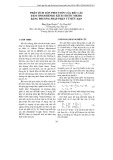
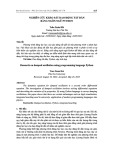
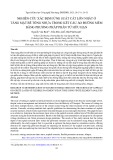


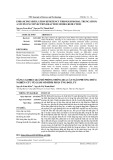
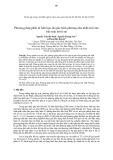














![Quyển ghi Xác suất và Thống kê [chuẩn nhất]](https://cdn.tailieu.vn/images/document/thumbnail/2025/20251030/anh26012006/135x160/68811762164229.jpg)
